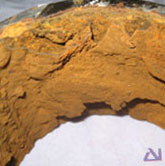Introduction
Following a leak from some chilled water pipes, where the wall of the pipe had been penetrated, a customer was concerned that there was a widespread problem of tube wall thinning. A visit was made to the customers’ site in order that lengths of tube of 50mm, 60mm and 90mm outside diameter could be tested ultrasonically to establish the extent of the wall thinning. Subsequent to the on-site ultrasonic testing, samples of the tube were brought back to the Burton Laboratory for further investigation. The samples were also subjected to visual examination, the results of which can be seen below.
Ultrasonic Examination
The ultrasonic examination was carried out on site and it is clear from the results that all of the tubes examined showed some degree of corrosion in the bore. The 50mm and 60mm OD tubes indicated small and minimal areas of corrosion respectively, however, the 90mm OD tube showed indications of substantial corrosion and material loss. In the 90mm diameter sample the wall thickness in some areas was determined to have been reduced to values as low as 2.75mm from a nominal 5mm originally.
Visual Examination

The samples brought back to the laboratory were examined using the naked eye and a low powered magnifier.

The samples were measured and found to have dimensions of 90mm nominal outside diameter and 5mm wall thickness. Examination of the inner surfaces of the tubes revealed that there were heavy deposits of red/brown Iron Oxide corrosion product present. The deposit was in the form of an adherent film, localised pustules and larger bridges that spanned substantial parts of the tube bore.

In positions where the sections through the tube passed through localised pustules it could be seen that a cap of oxide had formed over an underlying pit.

In other locations the oxide cap had been removed and the presence of a much larger pit could be observed.
The remaining wall thickness associated with some of these pits was measured and found to range from 2.11mm to 3.69mm.
Discussion and Conclusion
The ultrasonic testing and visual examination of the samples showed that there had been a significant degree of corrosive attack to the inner surface of the tubes. This had resulted in areas where the wall thickness had been reduced to a minimum measured value of 2.11mm from a nominal 5mm on the sections examined. It is unlikely that the planes of the sections taken would have passed through the most severely pitted locations and so would be the areas of lowest residual wall thickness. Therefore, there will probably be deeper pits which would be even closer to penetration of the tube wall.
The characteristics exhibited by the corrosion deposits, the manner in which they had formed and the associated pitting was indicative of a mechanism known as Oxygen (or differential aeration) Pitting. This is caused by the presence of Oxygen in the water flowing through the tubes. Normally the occurrence of this mechanism of corrosion and pitting is significantly reduced or eliminated completely by treating the feed water with chemicals that scavenge the Oxygen and so reduce it to a significantly lower level. However, once pitting has been initiated the geometry of the hole formed causes the bottom of the pit to become more Anodic with respect to the nominal bore surface due to localised depletion of Oxygen. As a result of this, material is lost and continues to be whilst the conditions that initiated the pitting prevail.